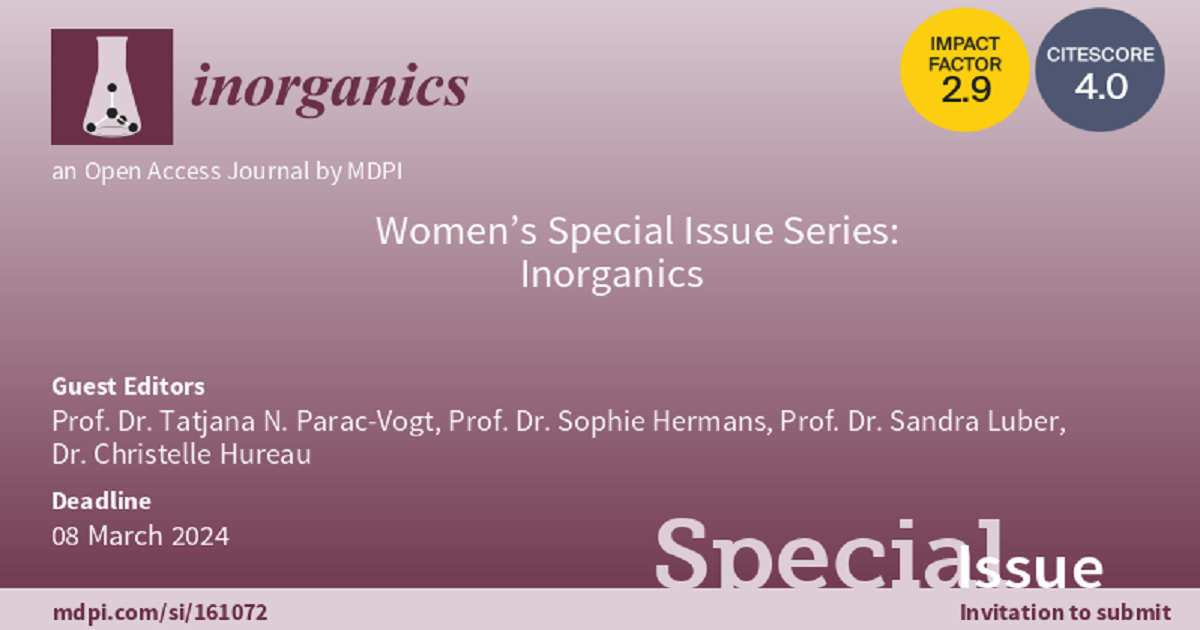Women’s Special Issue Series: Inorganics
A special issue of Inorganics (ISSN 2304-6740).
Deadline for manuscript submissions: closed (8 March 2024) | Viewed by 7609

Special Issue Editors
Interests: polyoxometalates (POMs); metal organic frameworks (MOFs); metal-oxo clusters; artificial metalloenzymes; bio-inspired catalysis
Interests: carbon-supported catalysts; biomass valorization; carbohydrate transformations; (nano-)carbon functionalization; nanoparticles synthesis; nanomaterials chemistry
Special Issues, Collections and Topics in MDPI journals
Interests: development and application of computational methods at the interface of chemistry, (bio-)physics, and materials science; spectroscopy; catalysis; static and dynamic ab initio methods; light-driven processes; chirality; liquids; interfaces; machine learning; in silico design
Special Issues, Collections and Topics in MDPI journals
Interests: bio-inorganic chemistry; metal-peptide interactions; metals as therapeutic targets; inorganic compounds as therapeutic agents; amyloid-forming peptides; EPR spectroscopy; electrochemistry
Special Issues, Collections and Topics in MDPI journals
Special Issue Information
Dear Colleagues,
We are delighted to present this special collection of articles that highlight the achievements of female scientists in (bio)inorganic chemistry, coordination chemistry, organometallic chemistry and inorganic materials, from all around the world. This Special Issue is devoted to presenting research performed by early and advanced career female scientists.
Inorganics is an open access journal that covers all aspects of inorganic chemistry research. Its primary areas of research interests include, but are not limited to, the following:
- Inorganic compounds, complexes and materials;
- Structures and bonding;
- Spectroscopic, magnetic, physical and chemical properties;
- Chemical reactivity, physical properties and applications;
- Mechanisms of inorganic reactions;
- Organometallic compounds;
- Inorganic cluster chemistry and nanoparticles;
- Heterogenous and homogeneous catalytic reactions;
- Thermodynamics and kinetics;
- Supramolecular systems and coordination polymers;
- Bio-inorganic chemistry and applications in biological systems;
- Environmental and sustainable energy applications.
Original research articles and comprehensive review papers where the lead authors are women, or that are completely authored by women, are encouraged. We welcome submissions from all authors, irrespective of gender.
Prof. Dr. Tatjana N. Parac-Vogt
Prof. Dr. Sophie Hermans
Prof. Dr. Sandra Luber
Dr. Christelle Hureau
Guest Editors
Manuscript Submission Information
Manuscripts should be submitted online at www.mdpi.com by registering and logging in to this website. Once you are registered, click here to go to the submission form. Manuscripts can be submitted until the deadline. All submissions that pass pre-check are peer-reviewed. Accepted papers will be published continuously in the journal (as soon as accepted) and will be listed together on the special issue website. Research articles, review articles as well as short communications are invited. For planned papers, a title and short abstract (about 100 words) can be sent to the Editorial Office for announcement on this website.
Submitted manuscripts should not have been published previously, nor be under consideration for publication elsewhere (except conference proceedings papers). All manuscripts are thoroughly refereed through a single-blind peer-review process. A guide for authors and other relevant information for submission of manuscripts is available on the Instructions for Authors page. Inorganics is an international peer-reviewed open access monthly journal published by MDPI.
Please visit the Instructions for Authors page before submitting a manuscript. The Article Processing Charge (APC) for publication in this open access journal is 2700 CHF (Swiss Francs). Submitted papers should be well formatted and use good English. Authors may use MDPI's English editing service prior to publication or during author revisions.
Benefits of Publishing in a Special Issue
- Ease of navigation: Grouping papers by topic helps scholars navigate broad scope journals more efficiently.
- Greater discoverability: Special Issues support the reach and impact of scientific research. Articles in Special Issues are more discoverable and cited more frequently.
- Expansion of research network: Special Issues facilitate connections among authors, fostering scientific collaborations.
- External promotion: Articles in Special Issues are often promoted through the journal's social media, increasing their visibility.
- e-Book format: Special Issues with more than 10 articles can be published as dedicated e-books, ensuring wide and rapid dissemination.
Further information on MDPI's Special Issue polices can be found here.








